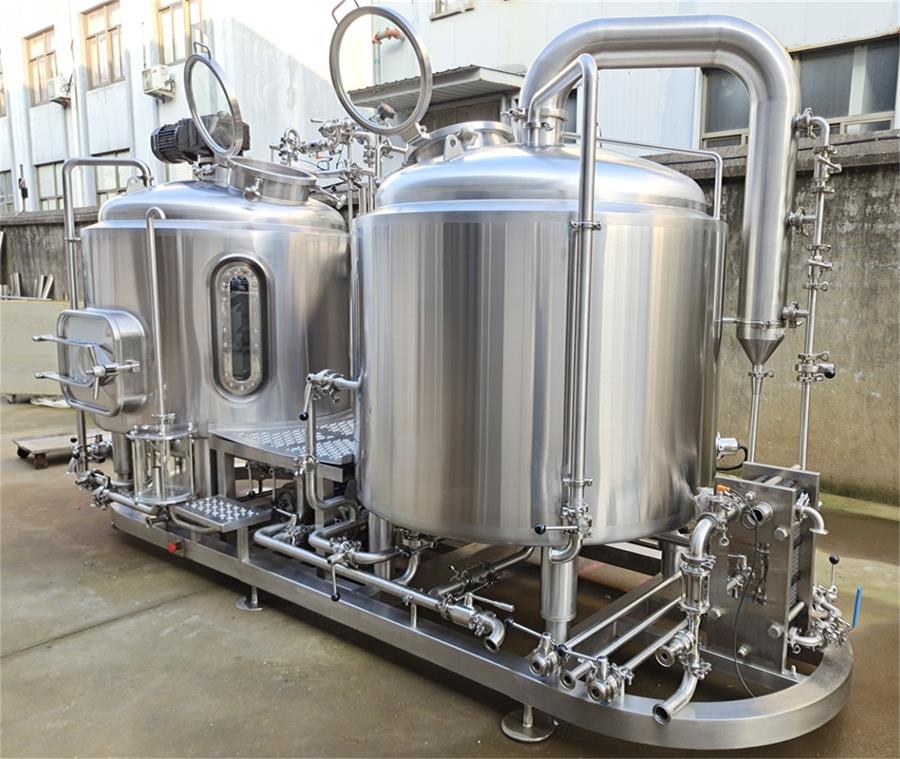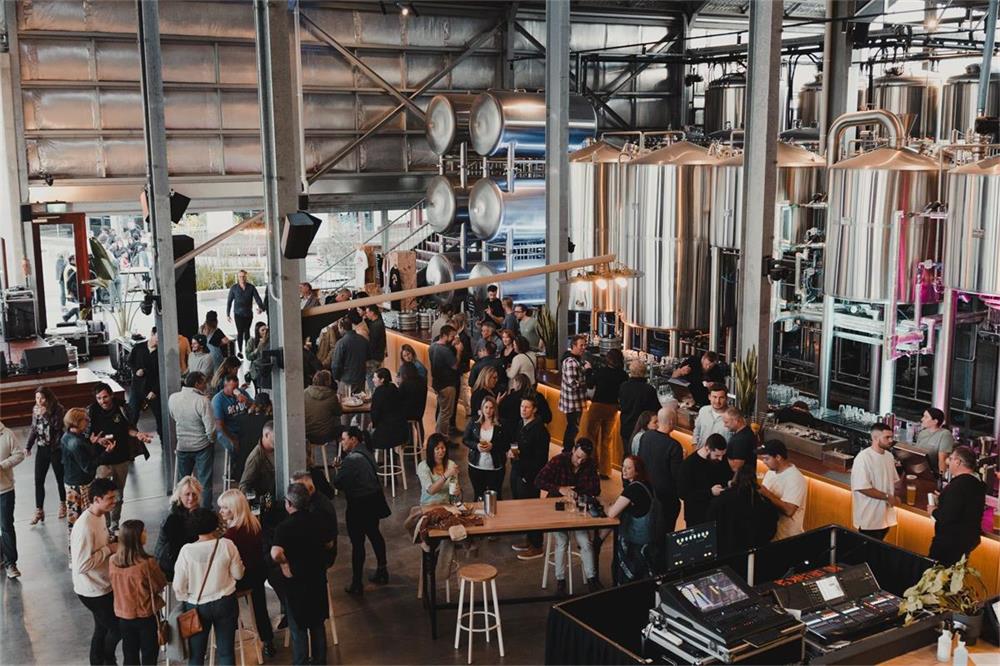Beer Brewery Setup
Imagine this: the rich aroma of hops fills the air, a copper kettle gleams under the lights, and the satisfying hiss of fermentation signals the birth of your own craft beer. For passionate beer enthusiasts, setting up a brewery is the ultimate dream, a chance to transform their love for the golden beverage into a creative outlet and, potentially, a thriving business. But before you dive headfirst into the world of malts and mashing, a well-planned beer brewery setup is crucial.
This guide will equip you with the knowledge to navigate the exciting, yet complex, world of beer brewery setup. Whether you’re a homebrewer yearning for a dedicated space or an aspiring entrepreneur ready to conquer the craft beer market, we’ll break down the essentials, from equipment selection to brewing processes and considerations for space and layout.
Unveiling the Essentials: A Guide to beer brewery setup
The heart of any brewery lies in its equipment. Here’s a breakdown of the key players:
| Equipment | Description |
|---|---|
| Mill/Grain Grinder | Crushes malted grains to expose starches for conversion into fermentable sugars during mashing. |
| Mash Tun/Lautering System | Vessel where crushed grains are steeped in hot water (mashing) to extract sugars, flavor, and color. |
| Kettle/Brew Kettle | Large pot used for boiling the wort (sugar extract) to sterilize it, concentrate flavors, and add hops. |
| Hot Liquor Tank (HLT) | Heats water to precise temperatures required for mashing and sparging (rinsing the grains after mashing). |
| Whirlpool Tank | Creates a swirling motion in the wort to separate hop trub (sediment) before fermentation. |
| Heat Exchanger | Rapidly cools the wort after boiling to a temperature suitable for yeast pitching. |
| Fermentation Tanks (Fermenters) | Stainless steel vessels where yeast converts wort sugars into alcohol and carbon dioxide. |
| Brite Tanks | Holds finished beer for conditioning, carbonation, and clarification before packaging. |
| Kegging System | System for filling, storing, and dispensing beer in kegs for draft sales or personal consumption. |
| Cleaning and Sanitation Equipment | Essential for maintaining a hygienic brewing environment to prevent contamination. |
Additional Considerations:
- Automation vs. Manual Systems: For smaller setups, manual systems offer greater control over the brewing process. However, larger breweries often benefit from automated controls for consistency and efficiency.
- Material Options: Stainless steel is the industry standard for its durability, sanitation ease, and resistance to corrosion.

Brewing Process Unveiled: From Grain to Glass
Now that you’re familiar with the equipment, let’s delve into the magical journey of transforming ingredients into your favorite beverage:
- Milling: Grains are crushed to expose starches for efficient sugar extraction during mashing.
- Mashing: Crushed grains are steeped in hot water for a specific time and temperature, allowing enzymes to convert starches into fermentable sugars.
- Lautering: Hot water (sparge water) is used to rinse the spent grains, extracting any remaining sugars.
- Boiling: The wort is transferred to the kettle and boiled. Hops are added at various stages to impart bitterness, aroma, and flavor.
- Whirlpooling: The wort is spun in a whirlpool tank to separate hop trub from the clarified wort.
- Cooling: The wort is rapidly cooled to a temperature suitable for yeast pitching.
- Fermentation: Cooled wort is transferred to fermenters, where yeast is pitched. Yeast consumes sugars and produces alcohol and carbon dioxide.
- Conditioning: After fermentation, beer is conditioned in tanks to allow flavors to mature and residual yeast to settle.
- Carbonation: Beer is then carbonated to achieve the desired level of fizz, either naturally through secondary fermentation or by injecting CO2.
- Packaging: Finally, the finished beer is packaged in kegs, bottles, or cans for distribution or enjoyment.
Designing Your Brewery: Space, Capacity, and Customization
The ideal brewery setup caters to your production goals, brewing style, and available space. Here are some key considerations:
Space:
- Homebrew vs. Commercial: Homebrewers can often utilize a dedicated corner in a garage or basement, while commercial breweries require significantly larger spaces to accommodate equipment, storage, and potentially, a tasting room.
- Workflow: Plan the layout to optimize workflow, minimizing unnecessary movement of
Price Range, Suppliers, and Considerations
Equipping your brewery can be an investment, so understanding the price ranges and factors affecting costs is crucial. Here’s a breakdown:
| Equipment | Price Range (USD) | Factors Affecting Cost |
|---|---|---|
| Mill/Grain Grinder | $100 – $5,000+ | Capacity, automation level, material (electric vs. manual) |
| Mash Tun/Lautering System | $500 – $20,000+ | Volume, material (single vs. combination vessel), features (integrated heating) |
| Kettle/Brew Kettle | $500 – $15,000+ | Volume, heating method (electric vs. steam), features (jackets for temperature control) |
| Hot Liquor Tank (HLT) | $1,000 – $25,000+ | Volume, heating method (electric vs. steam), features (insulation) |
| Whirlpool Tank | $500 – $10,000+ | Volume, material, features (integrated pump) |
| Heat Exchanger | $500 – $5,000+ | Capacity (how quickly it can cool wort), material |
| Fermentation Tanks (Fermenters) | $1,000 – $20,000+ | Volume, material (stainless steel vs. plastic), pressure rating (for ales vs. lagers) |
| Brite Tanks | $2,000 – $30,000+ | Volume, pressure rating, features (carb stone for carbonation) |
| Kegging System | $500 – $5,000+ | Number of kegs, cleaning equipment, CO2 tank |
| Cleaning and Sanitation Equipment | $200 – $1,000+ | Sprayers, pumps, cleaning chemicals |
Supplier Selection:
- Reputation: Choose established suppliers known for quality equipment and reliable customer service.
- Warranty: Look for equipment with comprehensive warranties to protect your investment.
- Scalability: Consider equipment that can accommodate future growth plans.
- Local vs. Online: Local suppliers offer in-person support, while online retailers might have wider selections and competitive pricing.
Installation, Operation, and Maintenance
Once your equipment arrives, proper installation, operation, and maintenance are essential for efficient brewing and long-lasting equipment.
| Stage | Description |
|---|---|
| Installation | Follow manufacturer’s instructions for proper setup and calibration. Ensure all connections are secure and leak-free. Consider professional installation for complex systems. |
| Operation | Familiarize yourself with each equipment’s operation manual. Practice brewing with simple recipes before attempting more complex styles. |
| Maintenance | Develop a regular cleaning and sanitation routine to prevent contamination. Regularly inspect equipment for wear and tear, and perform necessary maintenance as recommended by the manufacturer. |
Choosing the Right Supplier
Finding the right supplier for your brewery equipment is crucial. Here’s a table outlining key factors to consider:
| Factor | Description |
|---|---|
| Product Selection | Ensure the supplier offers equipment that matches your brewing needs and capacity. |
| Pricing and Value | Compare prices across different suppliers while considering quality, features, and warranty. |
| Customer Service | Opt for a supplier with a reputation for responsive and knowledgeable customer support. |
| Technical Support | Inquire about technical support availability for installation, troubleshooting, and maintenance. |
| Shipping and Lead Times | Understand shipping costs and lead times to ensure equipment arrives when needed. |
The Pros and Cons of beer brewery setup Options
Manual vs. Automated Systems:
- Manual:
- Pros: Offers greater control over the brewing process, less expensive upfront cost.
- Cons: More labor-intensive, requires a higher level of brewing knowledge.
- Automated:
- Pros: Ensures consistency, reduces manual labor, saves time.
- Cons: Higher initial cost, less flexibility for experimentation.
Electric vs. Steam Heating:
- Electric:
- Pros: Easier to install and operate, cleaner burning.
- Cons: May require higher electrical capacity, potentially higher energy costs.
- Steam:
- Pros: More efficient for large-scale brewing, faster heating times.
- Cons: Requires a dedicated boiler system, additional plumbing and safety considerations.

FAQ
Q: How much does it cost to set up a brewery?
A: The cost of setting up a brewery can vary widely depending on several factors, including:
- Scale: Homebrew setups can range from a few hundred dollars to a few thousand, while commercial breweries can cost millions of dollars to establish.
- Location: Rent and property costs can vary significantly depending on your location. Urban areas will generally be more expensive than rural locations.
- Equipment: The type and quality of equipment you choose will significantly impact the overall cost.
- Business Model: Costs will differ based on whether you plan to sell draft beer on-site, distribute in bottles or cans, or offer a combination of both.
Here’s a rough estimate of brewery setup costs:
- Homebrew Setup: $500 – $5,000+
- Microbrewery: $250,000 – $1,000,000+
- Production Brewery: $1,000,000+
It’s important to develop a detailed business plan that outlines your specific needs and budget. This will help you determine the most cost-effective approach for your brewery setup.
Q: What permits and licenses do I need to open a brewery?
A: The specific permits and licenses required to operate a brewery will vary depending on your location. Generally, you’ll need:
- Federal Permit: A Brewer’s Notice from the Alcohol and Tobacco Tax and Trade Bureau (TTB).
- State License: A license to manufacture and sell alcoholic beverages from your state’s alcohol beverage control board (ABC).
- Local Permits: Permits from your local municipality may be required, such as zoning permits and business operation licenses.
Consulting with a lawyer specializing in alcohol beverage law is recommended to ensure you obtain all necessary permits and comply with all regulations.
Q: What are the ongoing costs of running a brewery?
A: Beyond the initial setup costs, there are ongoing expenses associated with running a brewery, including:
- Ingredients: The cost of malt, hops, yeast, and other brewing ingredients.
- Utilities: Water, electricity, and potentially natural gas for heating.
- Packaging: Kegs, bottles, or cans for distributing your beer.
- Marketing and Advertising: Promoting your brewery and brand.
- Salaries and Payroll: If you have employees, you’ll need to factor in salaries, benefits, and payroll taxes.
- Rent or Mortgage: The cost of leasing or owning your brewery space.
Developing a sound financial plan that considers both startup and ongoing operational costs is crucial for the long-term success of your brewery.
Q: What resources can help me learn more about setting up a brewery?
A: Several resources can be valuable for aspiring brewers:
- Brewer’s Associations: National and regional brewer’s associations offer educational resources, networking opportunities, and industry support.
- Online Forums and Communities: Online communities connect brewers with a wealth of knowledge and experience to share.
- Books and Magazines: Numerous publications cover brewing techniques, business aspects, and industry trends.
- Professional Brewers Courses: Consider enrolling in brewing courses offered by reputable institutions to gain practical knowledge and skills.
Share this entry
Interested in learning more about Brewing Systems including additional details and pricing information? Please use the form below to contact us!
YOLONG BREWERY EQUIPMENT FAQS
- Commercial Brewery / Craft Brewery / Microbrewery / Nanobrewery
- What is The Difference Between Craft Beer and Industrial Beer?
- The Bespoke Differences In Custom Brewing Systems
- Everything You Need to Know About Kettle Souring
- How to Choose Brewing Equipment for Your business?
- How To Choose The-Best Partner To Build Your Commercial Microbrewing System?
- Two Detection Sensors That You Need To Use In Your Brewhouse System
- Remote Control Applications in Brewing Equipment/How does it work?
- How To Clean Your Brand New Brewery Tanks?

